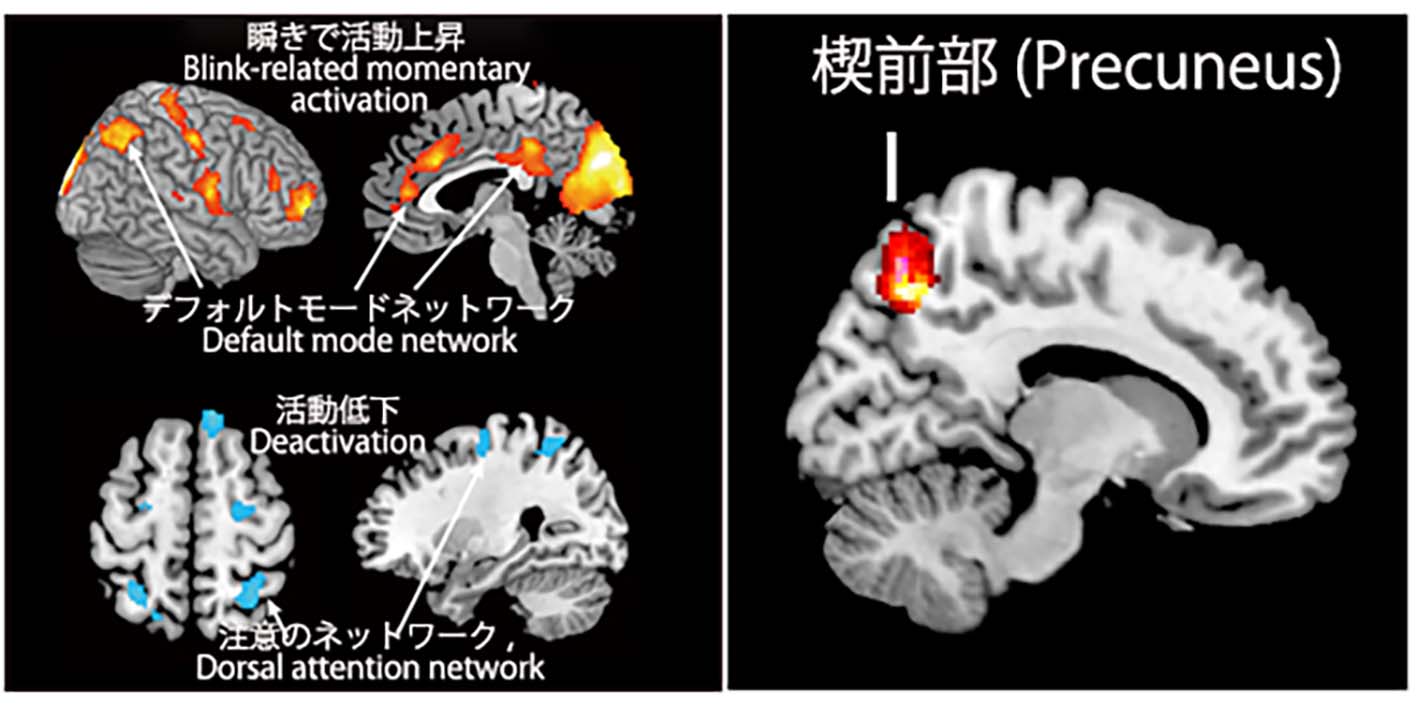Neuroscience Laboratories
Dynamic Brain Network Laboratory
 Prof. KITAZAWA Shigeru
Prof. KITAZAWA Shigeru
Keywords:
Cognitive brain science, Spatial cognition, Perception of time, Social cognition, Motor learning
Understanding brain functions as those of dynamic networks
Functions of the human brain ranges from perception, motor control, and cognition, to communication. Since the discovery of Broca’s area in 1861, brain researches has been developed by localizing each individual function to a specific region in the brain. However, any function cannot be achieved in one localized area, each individual column, or single neuron. Functions can only be achieved through dynamic collaboration across multiple “localized” areas of the brain. Our Dynamic Brain Network Laboratory aims at finding the principle of such collaboration across multiple regions. Functions being studied are 1) the perception of time, 2) motor learning, 3) visual stability, and 4) social communication.

Left: Blink-related momentary activation of the default mode network (top) and deactivation of the dorsal attention network (bottom). Right: The precuneus, which occupies the center of the brain network, is likely to be representing the origin of our space and time perception (the here and now).
Please visit Lab home page for more details.
Members
| Shigeru Kitazawa Professor | kitazawa[at]fbs.osaka-u.ac.jp |
|---|---|
| Masato Inoue Specially GuestAssociate Professor | m-inoue[at]fbs.osaka-u.ac.jp |
| Kei Watanabe AssociateProfessor | kei_watanabe[at]fbs.osaka-u.ac.jp |
| Masanori Saruwatari Assistant Professor | ms[at]fbs.osaka-u.ac.jp |
| Mikio Inagaki | |
| Murai Yuki | |
| Shibusawa Shuka | |
| Reiji Tanaka D4 | |
| Kyoko O'neill D2 | |
| Du Qinbo D2 | |
| Suzuki Hirotaka D2 | |
| Cao Xin Yu D1 | |
| WU HongSheng D1 | |
| Cui Shengbin D2 | |
| Takuto Yamamoto D1 | |
| Chinatsu Marumo Medical student | |
| Haruka Kato Technician | |
| Yoshika kaneda Secretary |
You could probably reach more information of individual researchers by Research Map and researcher's search of Osaka-U.
- ※Change [at] to @
Q&A
- What is your hot research topic?
- We are now interested in elucidating the functions of the precuneus. The precuneus, the core region of the default mode network, is likely to represent the origin of our space and time perception (the here and now). The default mode network, which was found to be activated after each eyeblink, occupies the center of the brain network.
- What is your breakthrough or research progress in the last 5 years?
- 1. We found that “the now” is represented in the precuneus (Tang et al., 2021).
2. We found that the dopamine reward sys
3. We found that neurons in the motor and parietal association cortices detect errors in reaching, and provide instructions on how to improve the movement (Inoue et al., 2016, 2018).
- What kind of background do your lab members have?
- Members in our lab have a variety of backgrounds that range from neurophysiology to cognitive neuroscience and engineering.
- Do you collaborate with other institutions and universities?
- We are collaborating with researchers at Johns Hopkins University, Lyon University, and others.
- What kind of careers do your Lab's alumni go on to?
- Some assume positions in universities, research institutes, hospitals, and others in companies.
- How do you develop your research?
- It is generally accepted that amyloid beta deposits begin to accumulate in the precuneus and the default mode network before the onset of Alzheimer's dementia. Our research on cognitive functions and the brain network will provide significant clues to understand pathophysiology of dementia.
Research Highlights
Publications (Research Articles, Reviews, Books)
2023
Optimal information loading into working memory explains dynamic coding in the prefrontal cortex
PNAS 120(48):e2307991120 2023 (PMID:37983510 DOI:10.1073/pnas.2307991120)
Cycles of goal silencing and reactivation underlie complex problem-solving in primate frontal and parietal cortex
Nature Communications 14(1):5054 2023 (PMID:37598206 DOI:10.1038/s41467-023-40676-1)
Ready to detect a reversal oftime’s arrow: a psychophysicalstudy using short video clipsin daily scenes.
Royal Society Open Science 10(4):230036 2023 (PMID:37090963 DOI:10.1098/rsos.230036)
2022
The salience network is activated during self-recognition from both first-person and third-person perspectives.
Human Brain mappinng 44(2):559-570 2022 (PMID:36129447 DOI:10.1002/hbm.26084)
Distinctive modes of cortical communications in tactile temporal order judgment.
Cerebral Cortex, 33(6):2982-2996 2022 (PMID:35811300 DOI:10.1093/cercor/bhac255)
You trust a face like yours.
?Humanities and Social Sciences Communications 9(1):226 2022 ( DOI:10.1057/s41599-022-01248-8)
2021
Self-Face Activates the Dopamine Reward Pathway without Awareness
Cerebral Cortex 31(10):4420-4426 2021 (PMID:33860315 DOI:10.1093/cercor/bhab096)
Neural correlates of temporal presentness in the precuneus: a cross-linguistic fMRI study based on speech stimuli.
Cerebral Cortex 31(3):1538-1552 2021 (PMID:33152751 DOI:10.1093/cercor/bhaa307)
2020
Adapting terminology: clarifying prism adaptation vocabulary, concepts, and methods.
Neurosci. Res. 153:8-21 2020 (PMID:30910735 DOI:10.1016/j.neures.2019.03.003)
Risk Factors Leading to Preference for Extreme Facial Retouching.
Cyberpsychology Behav. Soc. Netw. 23(1):52-59 2020 (PMID:31851844 DOI:10.1089/cyber.2019.0545)
2019
Statistical Significance Assessment of Phase Synchrony in the Presence of Background Couplings: An ECoG Study
Brain Topogr. 32(5):882-896 2019 (PMID:31129754 DOI:10.1007/s10548-019-00718-8)
Focused Representation of Successive Task Episodes in Frontal and Parietal Cortex
Cereb. Cortex 30(3):1779-1796 2019 (PMID:31690931 DOI:10.1093/cercor/bhz202)
Automatic encoding of a target position relative to a natural scene
J. Neurophysiol. 122(5):1849-1860 2019 (PMID:31509471 DOI:10.1152/jn.00032.2018)
Prism adaptation: From rehabilitation to neural bases
Cortex 111:A1-A6 2019 (PMID:30704673 DOI:10.1016/j.cortex.2019.01.002)
2018
Blink synchronization is an indicator of interest while viewing videos
Int. J. Psychophysiol. 135:1-11 2018 (PMID:30428333 DOI:10.1016/j.ijpsycho.2018.10.012)
Motor error in parietal area 5 and target error in area 7 drive distinctive adaptation in reaching
Curr. Biol. 28:2250-2262 2018 (PMID:29983313 DOI:10.1016/j.cub.2018.05.056)
Causal explanation of individual differences in human sensorimotor memory formation
bioRxiv 2018 ( DOI:10.1101/255091)
2017
Dual use of rectangular and triangular waveforms in voltammetry using a carbon fiber microelectrode to differentiate norepinephrine from dopamine
J. Electroanal. Chem. 802:1-7 2017 ( DOI:10.1016/j.jelechem.2017.08.037)
Transient heart rate acceleration in association with spontaneous eyeblinks
Int. J. Psychophysiol. 121:56-62 2017 (PMID:28890182 DOI:10.1016/j.ijpsycho.2017.09.003)
Modulation of illusory reversal in tactile temporal order by the phase of posterior alpha rhythm
J. Neurosci. 37(21):5298-5308 2017 (PMID:28450538 DOI:10.1523/JNEUROSCI.2899-15.2017)
Restricted transfer of learning between unimanual and bimanual finger sequences
J. Neurophysiol. 117(3):1043-1051 2017 (PMID:27974447 DOI:10.1152/jn.00387.2016)
A group of very preterm children characterized by atypical gaze patterns
Brain Dev. 39(3):187-195 2017 (PMID:27814930 DOI:10.1016/j.braindev.2016.10.001)
Development of long-term event memory in preverbal infants: an eye-tracking study
Sci Rep 7:187-276 2017 (PMID:28272489 DOI:10.1038/srep44086)
The Right Angular Gyrus Controls Spontaneous Eyeblink Rate: A Combined Structural MRI and TMS Study
Cortex 88:186-191 2017 (PMID:28142027 DOI:10.1016/j.cortex.2016.12.022)
Short-latency allocentric control of saccadic eye movements.
J. Neurophysiol. 117(1):376-387 2017 (PMID:27784804 DOI:10.1152/jn.00451.2016)
A group of very preterm children characterized by atypical gaze patterns.
Brain Dev. 39(3):218-224 2017 (PMID:27814930 DOI:10.1016/j.braindev.2016.10.001)
2016
Error signals in motor cortices drive adaptation in reaching.
Neuron 90:1-13 2016 (PMID:27181058 DOI:10.1016/j.neuron.2016.04.029)
Similar impressions of humanness for human and artificial singing voices in autism spectrum disorders
Cognition 153:1-5 2016 (PMID:27107740 DOI:10.1016/j.cognition.2016.04.004)
Blink and you'll miss it: the role of blinking in the perception of magic tricks
PeerJ 4:e1873 2016 (PMID:27069808 DOI:10.7717/peerj.1873)
Differences in the Pulsatile Component of the Skin Hemodynamic Response to Verbal Fluency Tasks in the Forehead and the Fingertip
Sci Rep 6:20978 2016 (PMID:26905432 DOI:10.1038/srep20978)
Our ideal candidate (as a graduate student)
We are looking for a highly motivated person to work on our research topics as our lab member.
Contact
Dynamic Brain Network Laboratory, Graduate School of Frontier Biosciences, Osaka University,
1-3 Yamadaoka, Suita, Osaka 565-0871 Japan.
TEL: +81-6-6879-4431
E-mail: kitazawa[at]fbs.osaka-u.ac.jp (Prof. Shigeru Kitazawa)
- ※Change [at] to @
